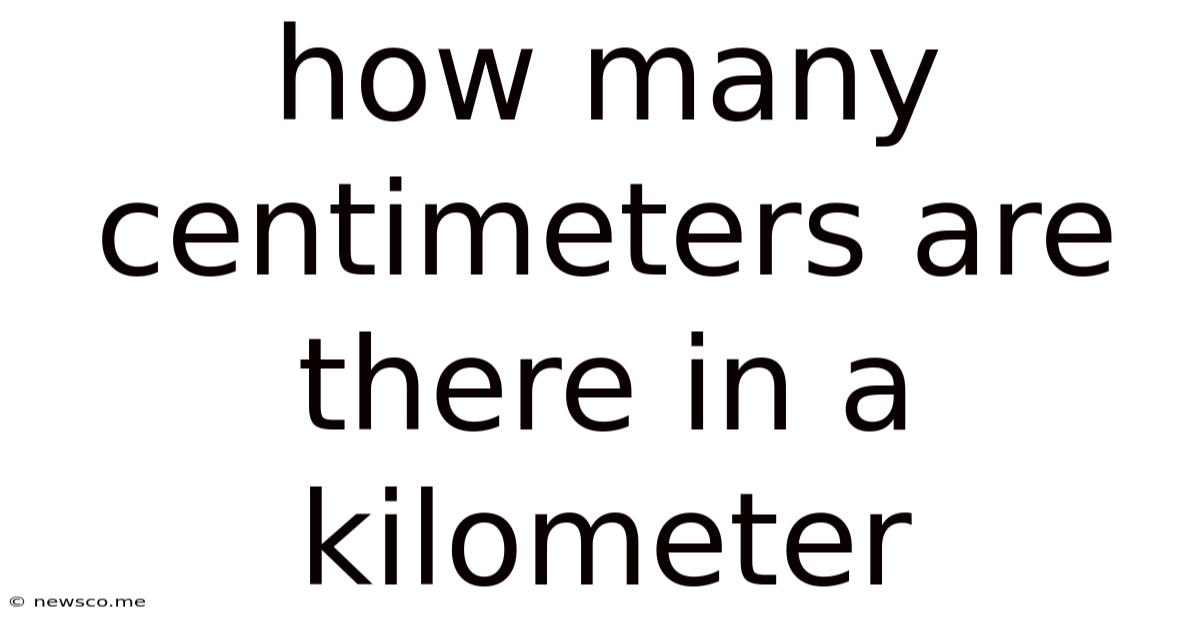How Many Centimeters Are There In A Kilometer
News Co
Apr 18, 2025 · 4 min read

Table of Contents
How Many Centimeters Are There in a Kilometer? A Deep Dive into Metric Conversions
Understanding metric conversions is crucial for anyone working with measurements, whether in scientific research, engineering projects, or everyday life. One common conversion that often causes confusion is determining how many centimeters are in a kilometer. This comprehensive guide will not only answer that question definitively but also explore the underlying principles of the metric system, provide practical examples, and offer tips for mastering metric conversions.
Understanding the Metric System
The metric system, officially known as the International System of Units (SI), is a decimal system based on powers of 10. This means that units are related by factors of 10, making conversions relatively straightforward compared to other systems like the imperial system. The fundamental unit of length in the metric system is the meter (m). All other units of length are derived from the meter using powers of 10.
Key Metric Prefixes
Understanding metric prefixes is essential for successful conversions. These prefixes indicate the multiples or submultiples of the base unit (in this case, the meter). Here are some key prefixes and their corresponding numerical values:
- Kilo (k): 1000 (one thousand)
- Hecto (h): 100 (one hundred)
- Deca (da): 10 (ten)
- Deci (d): 0.1 (one-tenth)
- Centi (c): 0.01 (one-hundredth)
- Milli (m): 0.001 (one-thousandth)
These prefixes can be applied to other base units like grams (mass) and liters (volume) as well.
From Kilometers to Centimeters: The Conversion
Now, let's tackle the main question: how many centimeters are there in a kilometer?
A kilometer (km) is 1000 meters (1 km = 1000 m). A centimeter (cm) is one-hundredth of a meter (1 cm = 0.01 m or 100 cm = 1 m). Therefore, to convert kilometers to centimeters, we need to perform a two-step conversion:
- Kilometers to Meters: Multiply the number of kilometers by 1000.
- Meters to Centimeters: Multiply the number of meters by 100.
Combining these steps, we get a single conversion factor:
1 km = 1000 m * 100 cm/m = 100,000 cm
Therefore, there are 100,000 centimeters in one kilometer.
Practical Examples and Applications
Let's solidify our understanding with some practical examples:
Example 1: A road is 5 kilometers long. How long is it in centimeters?
- 5 km * 100,000 cm/km = 500,000 cm
The road is 500,000 centimeters long.
Example 2: A map shows a distance of 2.5 kilometers between two cities. What is this distance in centimeters?
- 2.5 km * 100,000 cm/km = 250,000 cm
The distance between the two cities is 250,000 centimeters.
Example 3: A scientist measures the length of a specimen to be 0.003 kilometers. What is this length in centimeters?
- 0.003 km * 100,000 cm/km = 300 cm
The specimen's length is 300 centimeters.
These examples demonstrate how easily we can convert kilometers to centimeters using the conversion factor we derived. This conversion is frequently used in various fields:
- Cartography: Converting map scales from kilometers to centimeters.
- Engineering: Calculating distances and dimensions in construction projects.
- Science: Measuring the length of objects or specimens under a microscope.
- Everyday Life: Determining distances for walking, running, or cycling.
Mastering Metric Conversions: Tips and Tricks
While the kilometer to centimeter conversion is straightforward, mastering metric conversions in general requires practice and understanding. Here are some helpful tips:
- Memorize the prefixes: Familiarizing yourself with the common metric prefixes (kilo, hecto, deca, deci, centi, milli) is the first step.
- Use conversion factors: Write out your conversion factors explicitly to avoid errors.
- Dimensional analysis: Ensure the units cancel out correctly during your calculations. This helps verify the accuracy of your conversion.
- Practice regularly: The more you practice, the more comfortable you'll become with metric conversions.
- Visualize: Imagine the relative sizes of different metric units to aid your understanding.
Beyond Kilometers and Centimeters: Exploring Other Conversions
The principles discussed here can be extended to other metric conversions. For instance, you can use similar techniques to convert:
- Kilometers to millimeters: Multiply the number of kilometers by 1,000,000 (1 km = 1,000,000 mm).
- Meters to millimeters: Multiply the number of meters by 1000 (1 m = 1000 mm).
- Centimeters to millimeters: Multiply the number of centimeters by 10 (1 cm = 10 mm).
- Kilometers to meters: Multiply the number of kilometers by 1000 (1 km = 1000 m).
Understanding the relationship between different metric units is fundamental for accurate calculations and problem-solving.
Conclusion: Embracing the Simplicity of the Metric System
The metric system's beauty lies in its simplicity and logical structure. Once you grasp the basic principles and practice regularly, converting between different units becomes effortless. Knowing that there are 100,000 centimeters in a kilometer is a valuable piece of knowledge, applicable in a wide range of contexts. By mastering metric conversions, you empower yourself with a powerful tool for understanding and interacting with the world around you. Remember to practice regularly, and you will find metric conversions become second nature. The consistent use of the base-10 system makes it a highly efficient and intuitive system for measurement. This efficiency translates to improved accuracy and reduced errors in various fields, enhancing productivity and minimizing potential issues.
Latest Posts
Related Post
Thank you for visiting our website which covers about How Many Centimeters Are There In A Kilometer . We hope the information provided has been useful to you. Feel free to contact us if you have any questions or need further assistance. See you next time and don't miss to bookmark.